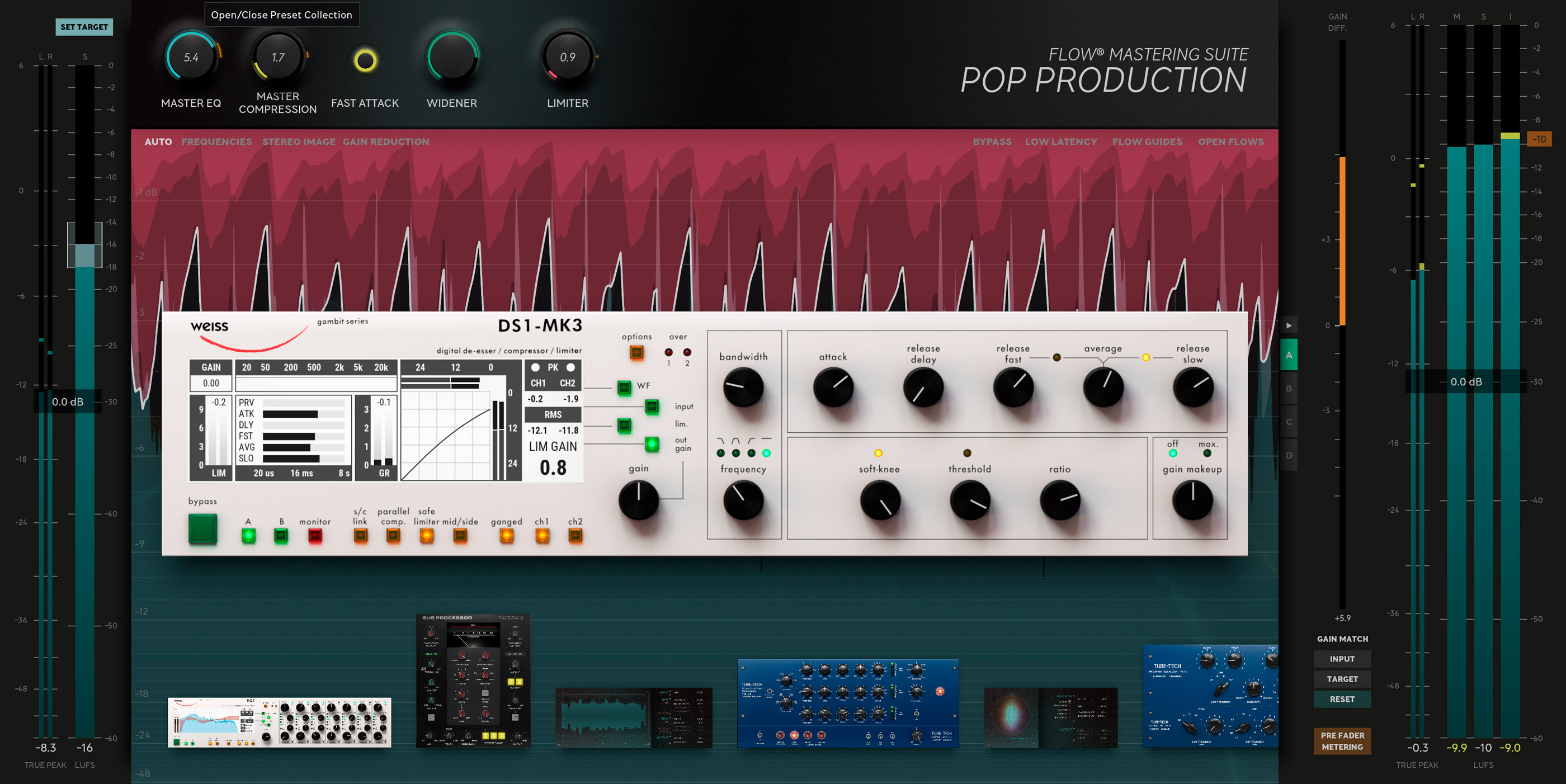Flow® Mastering Suite | Go to the product page
Limiter Features: Understanding True Peak Metering and Dithering
There are a few considerations regarding the use of Flow® Mastering Suite, as well as some technical terms and guidelines for mastering. Below are some thoughts on how to approach using the product, while giving some basic background for limiting, output levels, metering and dithering.

What is True Peak limiting?
Even when using limiting as a safeguard, so called inter-sample peaks can occur after digital-to-analog conversion (DAC) or when converting to lossy formats like MP3. In this conversion, peaks that occur between the sampled points of a digital audio signal (inter-sample peaks) can cause distortion if they exceed 0 dBFS. True peak limiting is used to ensure that these peaks do not exceed a specified threshold. The drawback with using True Peak limiting is that you might not be able to achieve a master as loud as without True Peak limiting. But, using different limiting algorithms can also be an aesthetic choice: Factors include choices in level of transparency, aggressiveness, more or less pronounced transients, or artifacts like pumping or even distortion.
Should you care about True Peak limiting?
Many professionally mastered albums contain inter-sample peaks, while still being considered “good sounding”. One conclusion from this might be that the peaks in themselves may not be an issue, it’s more about if they are noticeable in a bad way or not. Another thing to consider is what you are aiming to achieve. There is a trade-off between “loud” and “clean”, and inter-sample peaks are a part of this equation. If your goal is “loud”, then you might need to have a few inter-sample peaks above 0 dB. See Recommended Output Levels for our take on how you should use Flow® Mastering Suite in this regard.

Recommended Operation
Here are some common situations where mastering or master-bus treatment is done, and our recommendation for setting output level and handling inter-sample peaks:
-
Processing the master-bus to get a feel for what the finished track might sound like: There’s no need to change any settings for the final limiter plug-in or the metering. The limiter will keep the peak signal below 0.0 dBFS.
-
Pitching a song that you want to sound “close-to-finished” to an artist/label or sending it for feedback: There’s no need to change any settings for the final limiter plug-in or the metering. The limiter will keep the peak signal below 0.0 dBFS.
-
Preparing a final master for a streaming service: There is much discussion about what the approach should be here, but if you want the recommended best practice, it’s this: refer to the peak and loudness target guidelines for the service. This will inform you how to set your output volume. The current guideline for Spotify is -1.0 dBTP as a safety margin, but these guidelines tend to change over time. Turn on True Peak Metering, check for True Peak clipping and adjust the Output level to adhere to the guidelines. If you want an even more safe approach regarding inter-sample peaks, turn on True Peak limiting.
-
Preparing a final master for CD: Keep the default settings in Flow® Mastering Suite. The recommended best practice here is to master to -0.1 dBFS. If you’re concerned about inter-sample peaks, turn on True Peak Metering, check for True Peak clipping and adjust the Output level. If you want an even more safe approach regarding inter-sample peaks, turn on True Peak limiting.
-
Preparing a final master for vinyl: This is an art in itself and it’s best to consult with literature or someone knowledgeable on the subject for best practices.
How to turn on True Peak Metering
To activate True Peak metering on the input and/or output panels – go to settings (cogwheel) in the Flow® Mastering Suite plugin window and select True Peak for the peak meter in the Input Panel and/or the Output Panel.
How to turn on True Peak Limiting
The Flows handle limiting a bit different depending on the sound that the Flows are built to achieve. For this reason, True Peak limiting might be turned on or off by default. To change the setting:
-
If the final limiter is Weiss DS1-MK3 or Weiss Compressor/Limiter, go into the Options panel (Options button on the Weiss DS1-MK3 and the “>>” button on Weiss Compressor/Limiter) and choose Limiter Type 2.
-
If the final limiter is the Weiss MM-1, there is no option to choose True Peak limiting.

Oversampling
Compared to running in 44.1kHz, the Flow® Mastering Suite plugin utilizes a 2x linear-phase oversampling for processing. Internally, fast compression/limiting or peak clipping algorithms, as well as True Peak detection, will oversample to 4x. The level of oversampling chosen is carefully selected to provide the best sound quality, lowest latency, and lowest possible CPU usage.
Dithering
Our recommendation is to use the built-in dithering in your DAW. This is to make sure that there is no processing happening after the dithering, which will undo the effects of the dithering. If you still want to use dithering within Flow® Mastering Suite, this can be done by choosing a Flow that has either Weiss DS1-MK3 or Weiss Compressor/Limiter as the final limiter. Go into the Options panel (Options button on the Weiss DS1-MK3 and the “>>” button on Weiss Compressor/Limiter) and choose type of dithering you want. In this case you must make sure that the Output volume is in the Output panel is set to 0.0 dB, otherwise the effect of the dithering will be lost.
Loudness Metering
The metering system in Flow® Mastering Suite fully complies with the ITU-R BS.1770 and EBU R128 standard, including True Peak metering when activated. The different types of metering can be changed in settings (cogwheel) both for the Input Panel and for the Output Panel.
